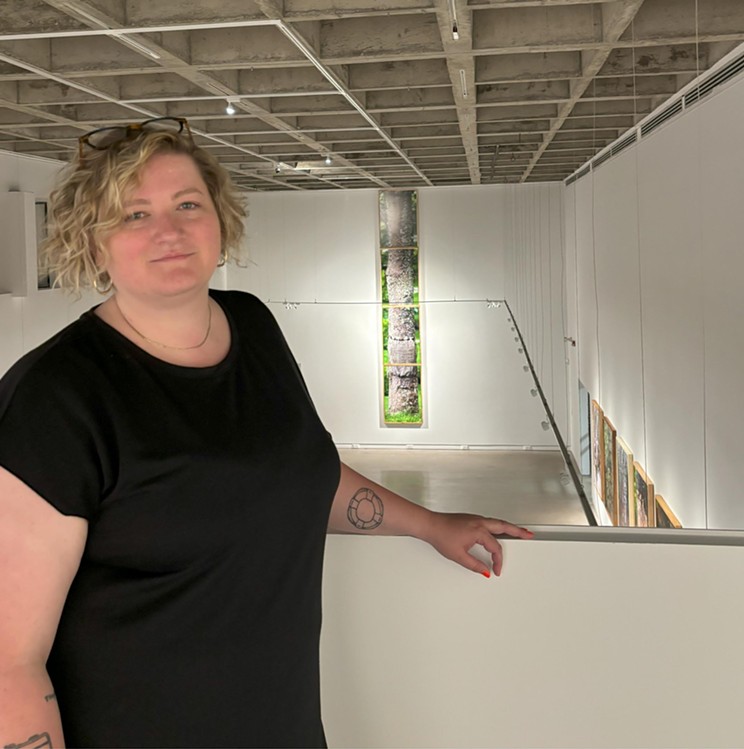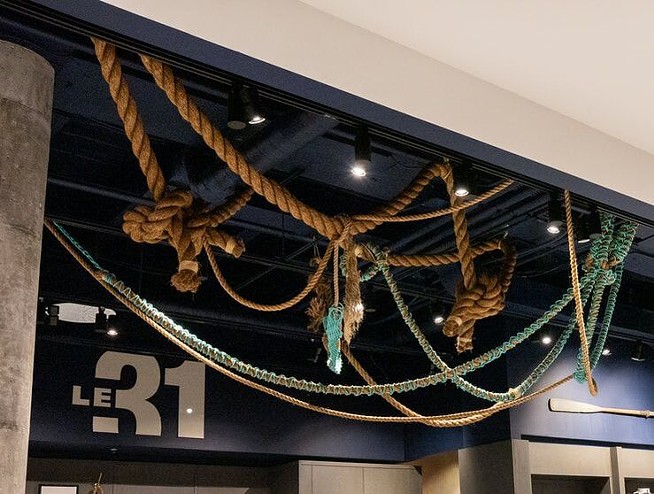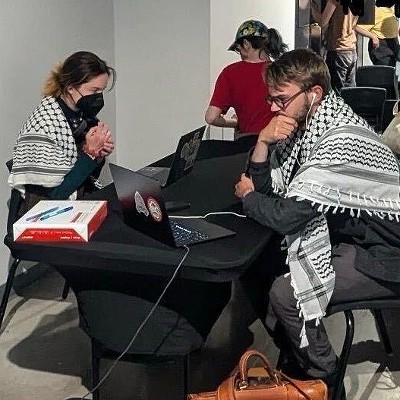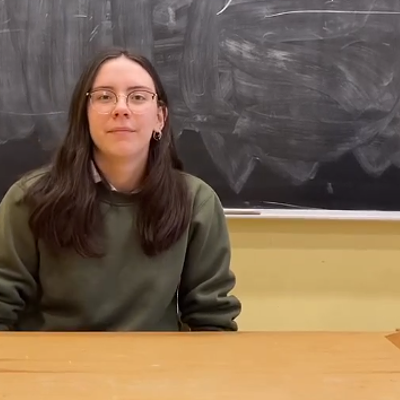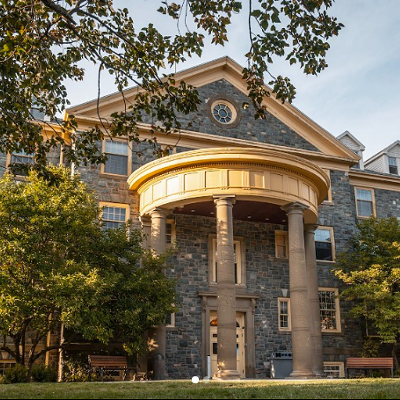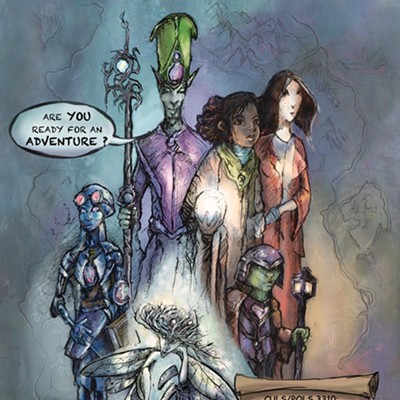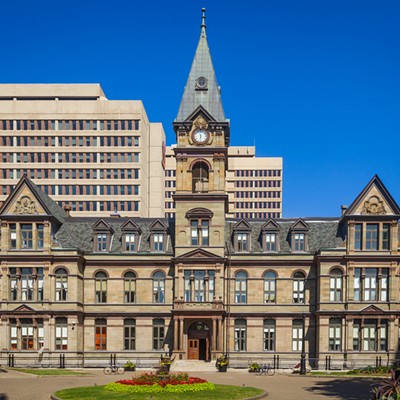A year ago, when Melanie Colosimo started as the new director of the Mount Saint Vincent University (MSVU) Art Gallery, she was worried about making relationships with students at a school without a fine arts program.
Colosimo had spent the last 15 years working in various positions at the Nova Scotia College of Art and Design (NSCAD) downtown, primarily within the Anna Leonowens (the Anna) Gallery System, having wrapped her time at NSCAD as director of the Anna before making the leap to MSVU.
The Anna saw 25,000 visitors per year, says Colosimo, which is different from MSVU which saw upwards of 2,000 during her first year on the job. NSCAD and the Anna also ran 100 exhibitions a year, with four a week, “which sounds wild—and it is—but it was such a well-oiled machine.”
In Halifax, however, the relationship between university art galleries and their degree programs is more similar to MSVU than NSCAD—Dalhousie University (Dal) and Saint Mary’s University (SMU) both have art galleries in their main campuses yet neither school offers fine arts degrees.
Says Colosimo, for MSVU students “art can be an answer in terms of posing new questions and opening new ways of seeing things.”
Colosimo sees MSVU as an opportunity for collaboration and exploration with other university galleries in town and across their own campus. “At MSVU, we have access to so many other disciplines that we can collaborate with to enhance what we exhibit to further the conversation.”
Colosimo says that because universities are protected by academic freedom, galleries can have more challenging exhibitions. As well, being a part of a university means alumni and donors can offer support through gifts of artworks to their permanent collection. Colosimo and her gallery team are currently working on a project to digitize MSVU’s collection so that what’s in the vault can be enjoyed online when it’s not showing.
“Anyone can benefit from interacting with art, be it traditional forms of what we think is visual art, like painting and drawing, or through craft mediums like pottery, textiles, ceramics and jewelry.”
The gallery also offers MSVU students gallery attendant and research positions, which has connected Colosimo with some NSCAD alumni who have gone to MSVU to pursue a Bachelor of Education degree. Through provincial and federal funding contracts, Colosimo has hired two students to work in the gallery—one of whom has since graduated but continues to work at the gallery—whose interests and pursuits at The Mount include history, archiving and languages.
The longest-serving gallery staff member is Traci Steylen, who works as an administrative assistant and has been with The Mount for three decades. “She’s fantastic,” says Colosimo.
The final member of the gallery team is David Dahms who works as the gallery technician and has been at The Mount for 12 years.
“We actually met working prep at the Art Gallery of Nova Scotia when I first moved to Halifax,” says Colosimo. “It’s been great to come back to us working together.” Colosimo says her background in art handling that she learned while working at the AGNS is helpful in her role as gallery director whenever there are moments “where we're short, something has happened and I needed to step in.” Plus, she says, “[Dahms] and I have worked so well together in the past that I can step in and help him install a show or pack work or just be an extra set of hands—but I'm not painting the walls anymore.”
The biggest drawback to the MSVU gallery is getting people out here, says Colosimo.
But once they arrive, “the space is beautiful: 21-and-a-half foot ceilings, lots of running wall space, a woodshop that’s connected to the gallery—there’s so many things we can do here.”
Founded in 1971 by then-president of MSVU, Catherine Wallace, the gallery’s mandate “has always been to prioritize women as artists and cultural producers and within the content of the exhibitions, as well,” says Colosimo. “It's what I have front of mind when I'm figuring out the [gallery’s] programming.”
Some of it has already been predetermined for Colosimo by her predecessor, Laura Ritchie who had been director of the gallery since 2019. Essentially, the director holds say on what is put up in the space, “but we work as a team,” Colosimo says. “If I have an idea for an exhibition—whether it’s from our permanent collection, or I want to curate a group show or bring in an artist—the first thing I do is sit with our team, and talk to them about it.”
Colosimo says talking to the students is important in the planning stages, too, “because they’re more connected with what's going on at the university and it’s important that we bring in exhibitions that are of interest to a majority of students, especially considering we’re not a fine arts school.”
For example, the gallery is able to highlight contemporary artists working within the field of education. The gallery recently exhibited a show called Life Cycle of a Boat in collaboration with the Two-Eyed Seeing Program, which is a grant-funded summer program offered in collaboration with MSVU, and the Mi’kmaw Kina’matnewey, which is the Mi’kmaw school board in Mi’kmaki Nova Scotia.
Their work digitizing the permanent collection means they’re able to group and introduce people to artists within, like Alice Mary Hagen, “who has been called Nova Scotia’s pioneer potter,” says Colosimo.
MSVU has over 100 pieces of her pottery, paintings and watercolours in their collection. Hagen was an MSVU graduate and a NSCAD graduate when it was then called the Victoria School of Art, says Colosimo. She was born in 1872 and lived until she was 100. “Her life’s mission seemed to be to get art education into elementary schools,” says Colosimo, “because she believed that giving children the opportunity to create would assist them in so many other avenues of their education.” In tandem with the Nova Scotia government, Hagen created a course in the late 1930s in which she taught teachers how to make pottery, which they would then bring into their classroom teaching in elementary schools and high schools. “That’s her legacy,” says Colosimo. “She was a promoter of the craft as a trade handicraft movement in Nova Scotia— quite incredible.”
Being focused on the Atlantic and on supporting women, the MSVU gallery's mandate lines up well with Colosimo’s own artistic practice. “Slipping into this role has been easy—though not without its challenges—but it’s been great.”
She says she has no regrets and feels like she has more autonomy at MSVU than she did at NSCAD—although there are days, Colosimo says, “that I really miss the community there.”
At NSCAD, “you're in the midst of all of these other artists—faculty, educators and students—who are always making, talking, speaking creatively and brainstorming and I definitely drew from that for my own studio practice.”
While that element is lessened at MSVU, says Colosimo, “it does give me more energy to be out in the community.” Because of how busy she was at the Anna, “you don't always have the extra energy to get to enjoy an exhibition opening or to make it to another artist talk.” At MSVU, the pace is more manageable. “I’m finding myself getting out to more events and becoming reacquainted with the other folks within the community and their practices when I have time for studio visits, etc.—so, it's been really great that way.”
Much of Colosimo’s work from her own artistic practice “reflect on labour practices and industries within the Atlantic that have significantly changed or no longer exist.” One of her works is featured on permanent display in the menswear department at Simon’s in the Halifax Shopping Centre—a commission called Community Ties.
It features many types of ropes, including lobster rope or nautical rope. Colosimo crocheted the ropes together using a hitching technique and says she sourced all the ropes locally.
“All of these different ropes are connected in some way within the piece,” says Colosimo. “I was thinking a lot about how the fishing industry so drastically changed in the ’90s and with the cod moratorium, and how that affected all of these coastline communities, and how they've had to adapt and change.”
Colosimo is interested in thinking about how this affected the women, mothers and wives in these communities who would have had to start working as a result. "There was a lot of alcoholism and spousal abuse, as well as community support disappearing as they would move away,” says Colosimo. The women who remained would lean on each other to support each other, “which is why a lot of church groups started,” she says, “and ‘stitch and bitches’ in these smaller areas, in order to build community.”
In Colosimo’s piece, the crocheted element represents “the women, and how they were such an integral part of keeping those communities and families together,” with all the different sizes of ropes standing in for all the different kinds of people within the communities and industries. “They all connect and overlap with different fishing knots that make things stronger and connect different sizes of rope together.”
Another piece of Colosimo’s work will appear in this year’s Nocturne art-at-night festival. She’s making “an inflatable representation of the Cogswell interchange.”
For this piece, she found archived radio shows from the ’60s and ’70s when the Cogswell interchange was being built, “and there were kids calling in and complaining about the destruction of the waterfront.” She describes her upcoming Nocturne piece as an “anti-monument to memorialize this thing that went up and divided the town—they always called it ‘the road to nowhere,’ because it was started and then never completed because there was so much community pushback.”
Colosimo is still adjusting to the new role at MSVU and balancing that with getting back into her own studio. “I feel like that part of my brain is quiet while I figure out this job but I'm starting to get back.”
The current exhibition at the MSVU gallery, called Collective from artists Miranda Bellamy and Amanda Fauteux, was something that Colosimo was, in a way, involved with before starting on at MSVU. “They were actually staying with me when they were taking the photos in the public gardens in 2022,” which appear in their current show. In 2023, when Colosimo got the new gig, Bellamy and Fauteux were visiting and telling her about their show, which they originally opened that year for the Art Gallery of Grand Prairie, in Alberta.
“When I got this job,” says Colosimo, “I knew this was the perfect gallery for this work because it's big, it's spacious, there’s a connection to Halifax as well as the [MSVU] campus’s own history” which involves a groundskeeper and trees donated by alumni and others. “We're hoping that there will be a campus tour with a map you can take on your own walk.”
Catch Colosimo inside the MSVU gallery next Saturday, July 27 at 1pm for an artist talk by Bellamy and Fauteux in conjunction with their show, Collective.

